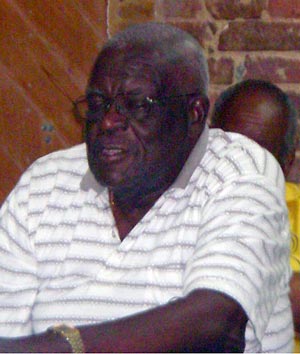Guy Benjamin, Kenneth Marsh, Edmond Roberts, Milton Samuel –Stories of the Last two Decades Presented to the SJHS Membership April 19, 2008
They did not have a formal presentation, they began, but would tell stories of life experiences, or of things they had heard, or that they knew about, that have to do with St John. There was much good natured laughter as this distinguished panel emphasized that these are not stories told by ‘old’ people, as this group isn’t very old, and that they interact and build on each other’s stories, but never try to correct each other. This is living history.
Mr. Roberts emphasized there are many images to evoke, and there were. These gifted storytellers can talk effortlessly and for a long time, intertwining information, entertainment, folklore, and history.

Pictured left to right are panel members
Kenneth Marsh, Guy Benjamin, and Edmond Roberts
(Photo by Kimberly Boulon)
Story telling is such an art; it’s trite but true that in the reading of a word-for-word transcription of a story, somehow the timing falters, the inflections fade, the charm diminishes and the impact of the story lessens. I have recently had the pleasure of transcribing tales told to VINP Ranger Mat Marsh by folks from two generations ago, and the value of the voice actually telling a story was as apparent in the Bethany Moravian church on April 19, 2008 as it was for the interviews of the 1970’s. The actual tapes and their musical and charming verbiage will be left for another venue. Here–a few highlights:The manner of story telling– If someone introduces the use of donkeys, another may begin speaking about picking up a donkey here and there for transportation, while another may build on that by speaking about using a donkey for work, e.g. the process of hauling gravel and sand in a dumb-box. At the end of it all, you gain an appreciation of how canny these little donkeys were, and how much more hardworking they were than the ‘flatlander’ mules imported from St Croix, who wouldn’t carry anything uphill! And as one interviewee pointed out in the 1970’s interviews– all the donkeys were still around after the 1916 hurricane–it was the other animals that suffered.The discovery of iterative story telling– Mr. Roberts pointed out that he only recently learned that people from Johns Folly went to Leduck to get water. Why would anyone go to Leduck when there was a spring up on Bordeaux? It turns out Leduck had natural pools that held water during dry periods, and people would paddle out there and bring it back in kerosene cans to Johns Folly and Hard Labor, areas like that, because it was much easier than climbing Bordeaux. Every story telling dredges up additional details about the past, especially with a lively participative audience.

Milton Samuel makes a point
(Photo by Kimberly Boulon)
The knowledge passed in storytelling– We learned a lot about pharmacopoeia at Bethany– that the painkiller bush, which we feed our pigs here, is quite valuable in Hawaii and that it’s used to cure arthritis, that soursop leaves in your hat will relieve a headache; that lemongrass tea will drink away a fever. And remember the leaf of life? (That’s the one you write your sweetheart’s name on and it readily grows ‘babies’ from the notches in the leaf.) It can be used as a tea to solve many chills and ills. As stories about island travel were told at Bethany, we learned almost incidentally the genealogy and physical geography of the island.The recounting of humor and high-jinks (by parents and children) is great story-telling– You might have guessed that adults used the threat of jumbies and werewolves to get the kids in the house by evening. You probably couldn’t have dreamed up a merchant’s sticking a dead yellow-breast (bananaquit) in a bunch of bananas to discourage people from stealing his bananas, nor could you guess the would-be thief might be overheard to say, “He put something in this banana, it even kill the bird.” One of my favorite recounted stories by Milton Samuel is the pea soup story– it seems that before there was food service in the schools, the girls did the cooking, and they always took the best of the soup for themselves before serving it, so one day he recalls putting the long black pods from the licorice tree (the rain tree), into the pea soup, thinking that if he didn’t get to share the meat, no-one else would get it. I also recall how he painfully described the reaction of his teacher, Mr. Guy Benjamin.Fable creation in storytelling– Do you know why (at least one) grandfather was bald? Charcoal making is one of those industries that’s described in the transcripts about life in the early 1900’s and also recounted by these storytellers. The types of trees varied; wild coffee was prized because it was hard and burned hot. One day grandfather was industriously and speedily delivering charcoal, coming down the back of Carolina Valley with a basket on his head,and upon hitting a straightway where the wind blew, it came alive again and burned his hat. And that’s why he’s bald! The story may be humorous and partially tongue in cheek, but the description of grandfather’s industriousness, the process and his skill at charcoal making, the detailed description of an industry, and this humor combine to make a memorable pass-down story.Please join us next year when we hope to convince this wonderful panel to return to share additional St. John history and folkways.
See the related items:
[Way of life]

